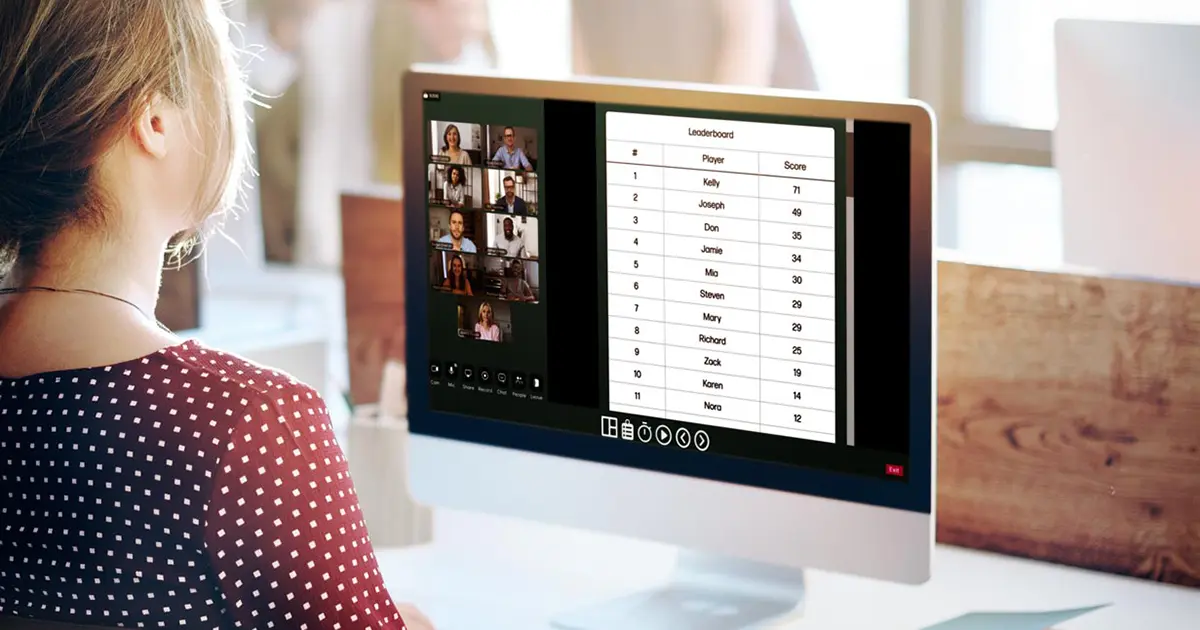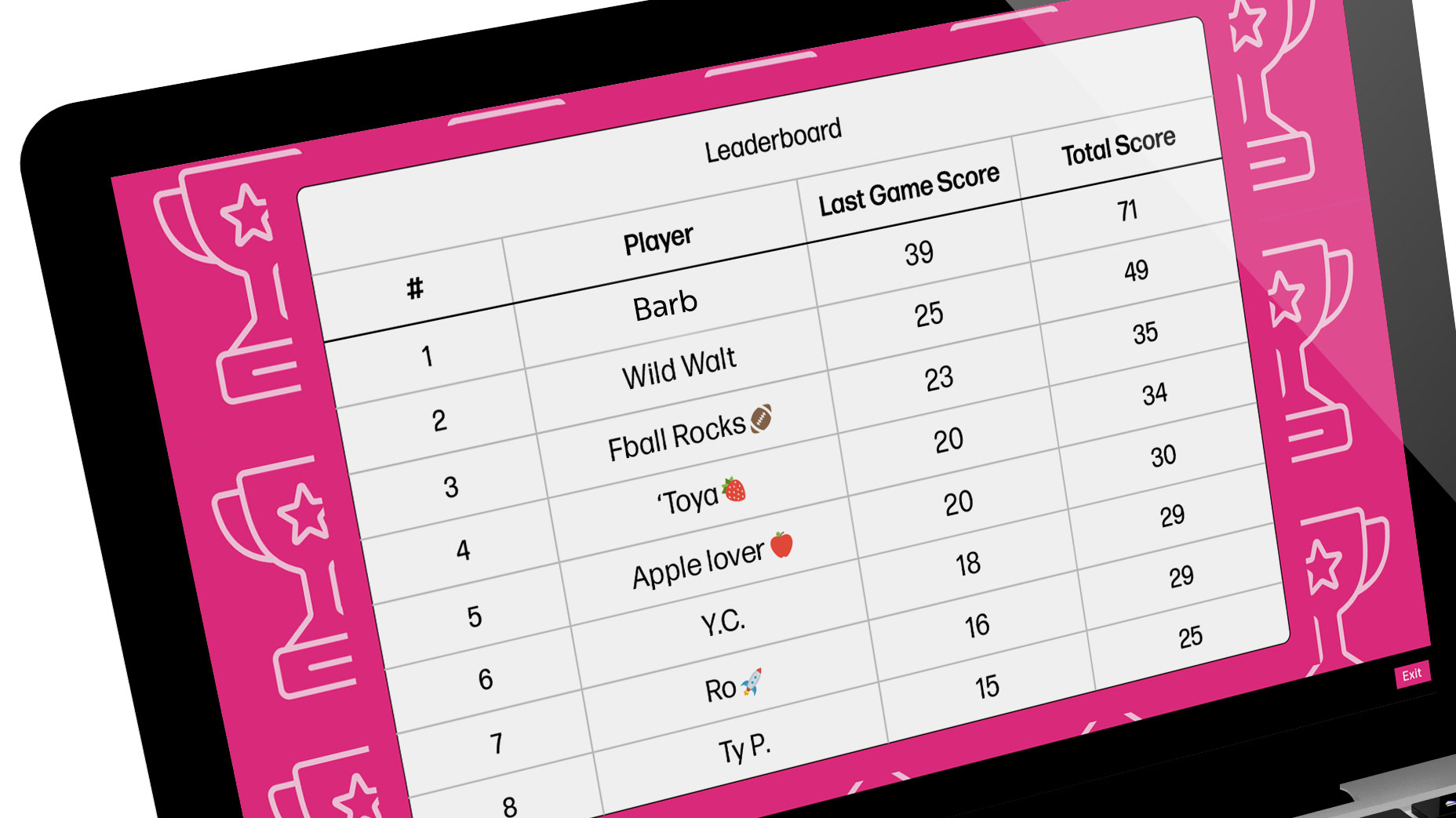See how leaderboards can create safe, healthy competition, increase participation, and provide motivation that drives positive learning outcomes.

In today’s attention-fragmented world, delivering content isn’t enough—you need to spark curiosity, energize participation, and create moments that matter. Enter leaderboards: a simple yet powerful mechanism that turns passive learning into dynamic performance. Whether you’re teaching in person, virtually, or on-demand, leaderboards inject urgency, visibility, and a healthy dose of competition.
This article explores how leaderboard-driven games supercharge engagement, highlights real-world applications, and offers tips for using REACHUM to bring your training to life.
Leaderboards tap into a basic human motivator: the desire to win—or at least improve. When used during virtual or live training sessions, they make progress visible and add excitement to what might otherwise be a forgettable experience.
We’ve seen it across the board—every group wants to win. That’s no surprise with sales teams, but what’s remarkable is how strongly this holds true for GED and ESL learners as well. These students, who are not always thought of as highly motivated, often turn out to be fiercely competitive. The moment a leaderboard appears, participation spikes. They lean in, take risks, and strive to improve. Competition, when framed positively, unlocks a level of drive and focus that might otherwise go untapped.
Take, for example, a recent executive board meeting where participants competed in a rapid-fire quiz about industry competitors. Within ten minutes, the CEO and CTO were neck-and-neck. Each round escalated the tension—cheers, banter, and some good-natured trash talk included. By round eight, the CTO edged out a narrow win. The session hadn’t even started officially, and already the energy in the room was sky-high.
That kind of momentum is rare in corporate learning, where studies show that over 70% of meetings are viewed as a “waste of time.” Leaderboards flip the script—encouraging collaboration, sparking dialogue, and aligning teams around shared goals. When paired with recognition and rewards, they become a powerful tool for driving both performance and morale.
Fun isn’t fluff. It’s fuel for memory and motivation. During live events, where instructors are fighting for learners’ attention, leaderboards provide a layer of gamified tension that keeps participants dialed in. Each challenge becomes a shared experience. Instructors can pause to analyze results, reinforce key points, and spark conversations that deepen understanding. And because feedback is immediate, learners stay immersed and eager for what’s next.
Leaderboard games also increase the level of interaction between learners and instructors. The competition commands attention, and creates opportunitoes for instructors to discuss results of every challenge.This help to create a more interactive and engaging learning experience, which can help to keep learners engaged and motivated to complete their learning objectives.
Virtual classrooms present a unique challenge: keeping learners engaged over long sessions with limited human contact. Leaderboards can dramatically change the dynamic.
REACHUM leaderboard games turn passive Zoom attendees into active participants. Whether you’re asking learners to diagnose a fictional patient or solve a timed compliance challenge, adding a leaderboard creates a sense of urgency and structure. Suddenly, everyone has a reason to lean in.
Want learners to practice objection handling? Launch a timed challenge where their responses are scored, ranked, and shared. Want to encourage knowledge application? Design a “mission” that rewards precision and speed.
By tying recognition to real progress, leaderboards help learners stay focused, competitive, and committed—even for three-hour sessions held twice a day.
To maintain a positive learning atmosphere, REACHUM typically recommends using game names instead of real participant names on leaderboards. Anonymity is normal in the world of online video games. This small adjustment protects learners from potential embarrassment and helps create a psychologically safe space—especially important in public education and mixed-ability groups. The exception? Competitive sales teams. In sales-driven cultures where leaderboard visibility fuels ambition and recognition, displaying real names can raise the stakes in all the right ways.
Creating a leaderboard game with REACHUM is as easy as filling out a form and setting a timer. With six prebuilt game types—and more on the way—you can launch engaging activities in minutes. Ideal sessions use 8- to 12-minute microlearning cycles to maximize attention and retention.
Start by identifying your learning objective. Then ask: How could I turn this into a challenge?
REACHUM’s leaderboard mechanics do the rest—tracking scores, ranking participants, and keeping learners coming back for more.

Leaderboards are more than bells and whistles. They’re a strategic tool for overcoming distraction, increasing retention, and building a culture of active learning. Whether you’re training a remote sales team, a healthcare cohort, or a group of GED students, a well-designed leaderboard game can set the tone, spark momentum, and drive results.
If your learning sessions feel like a grind, it’s time to make them a game.